Business Strategy
VerifiedAdded on 2022/12/15
|15
|4698
|1
AI Summary
Please see atached docs and use them .
The teacher is verry specific about using as manny analisys tools as possible like 7P BGs Matrix Swot etc
Also please make assignment make sens
Thank you
Contribute Materials
Your contribution can guide someone’s learning journey. Share your
documents today.
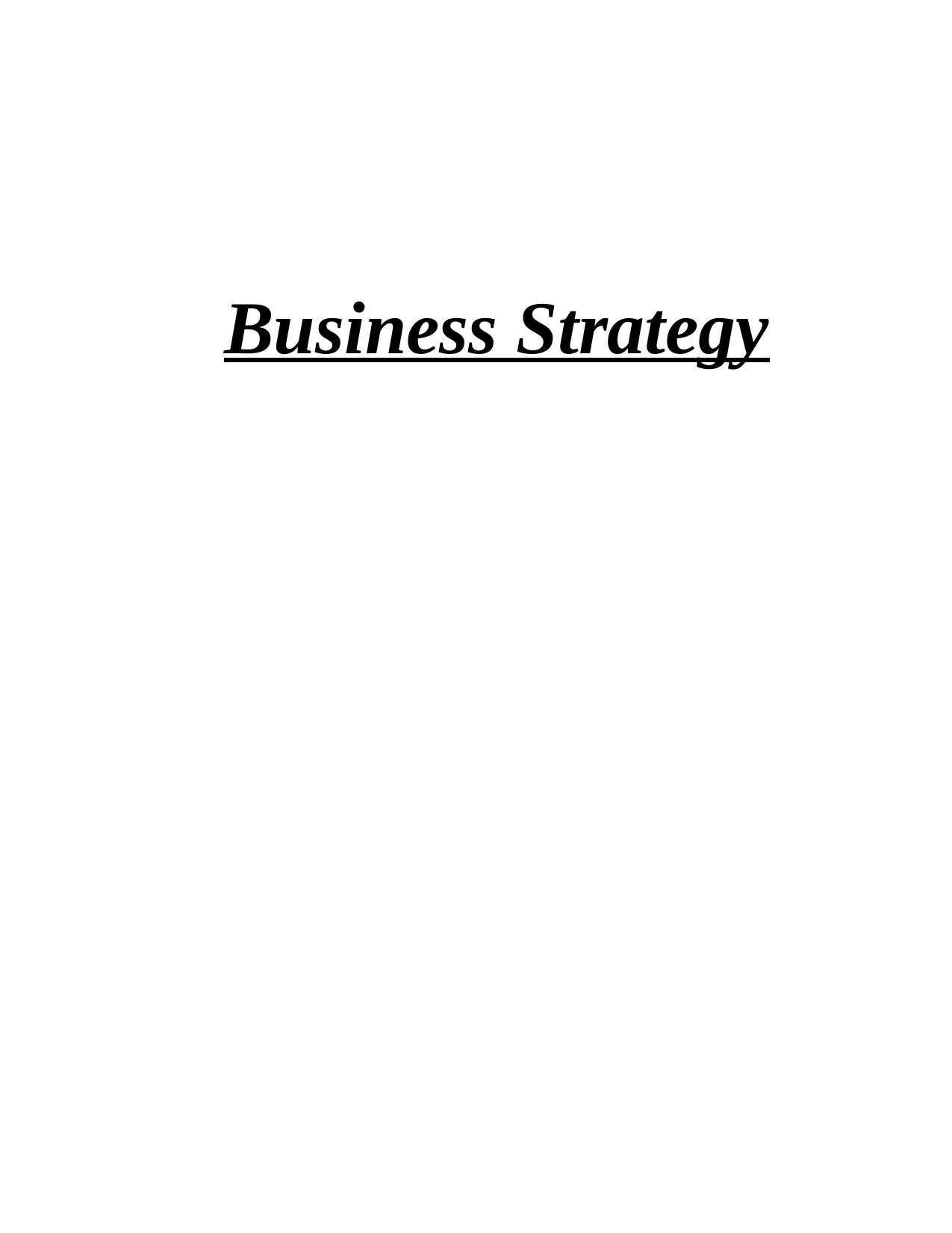
Business Strategy
Secure Best Marks with AI Grader
Need help grading? Try our AI Grader for instant feedback on your assignments.
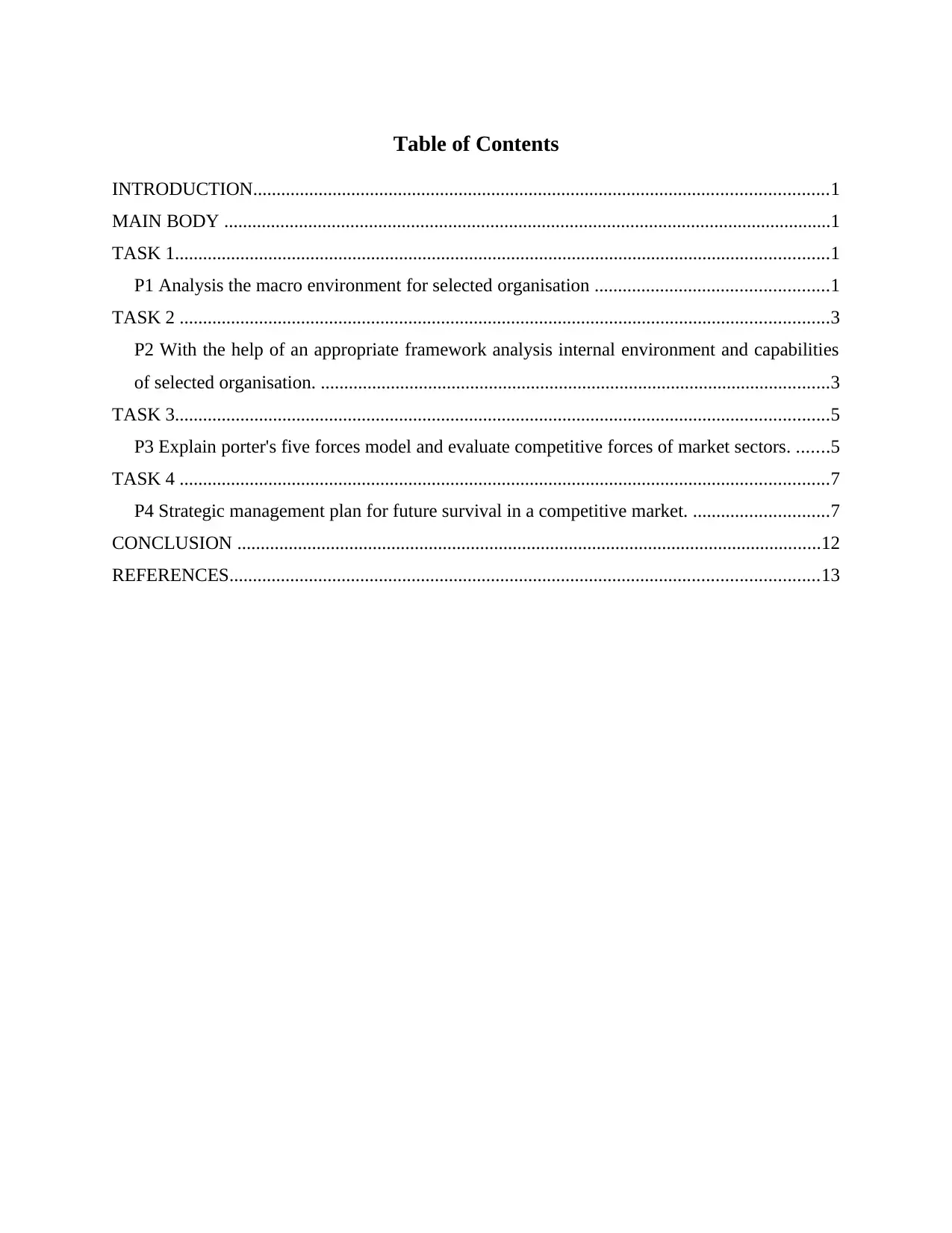
Table of Contents
INTRODUCTION...........................................................................................................................1
MAIN BODY ..................................................................................................................................1
TASK 1............................................................................................................................................1
P1 Analysis the macro environment for selected organisation ..................................................1
TASK 2 ...........................................................................................................................................3
P2 With the help of an appropriate framework analysis internal environment and capabilities
of selected organisation. .............................................................................................................3
TASK 3............................................................................................................................................5
P3 Explain porter's five forces model and evaluate competitive forces of market sectors. .......5
TASK 4 ...........................................................................................................................................7
P4 Strategic management plan for future survival in a competitive market. .............................7
CONCLUSION .............................................................................................................................12
REFERENCES..............................................................................................................................13
INTRODUCTION...........................................................................................................................1
MAIN BODY ..................................................................................................................................1
TASK 1............................................................................................................................................1
P1 Analysis the macro environment for selected organisation ..................................................1
TASK 2 ...........................................................................................................................................3
P2 With the help of an appropriate framework analysis internal environment and capabilities
of selected organisation. .............................................................................................................3
TASK 3............................................................................................................................................5
P3 Explain porter's five forces model and evaluate competitive forces of market sectors. .......5
TASK 4 ...........................................................................................................................................7
P4 Strategic management plan for future survival in a competitive market. .............................7
CONCLUSION .............................................................................................................................12
REFERENCES..............................................................................................................................13
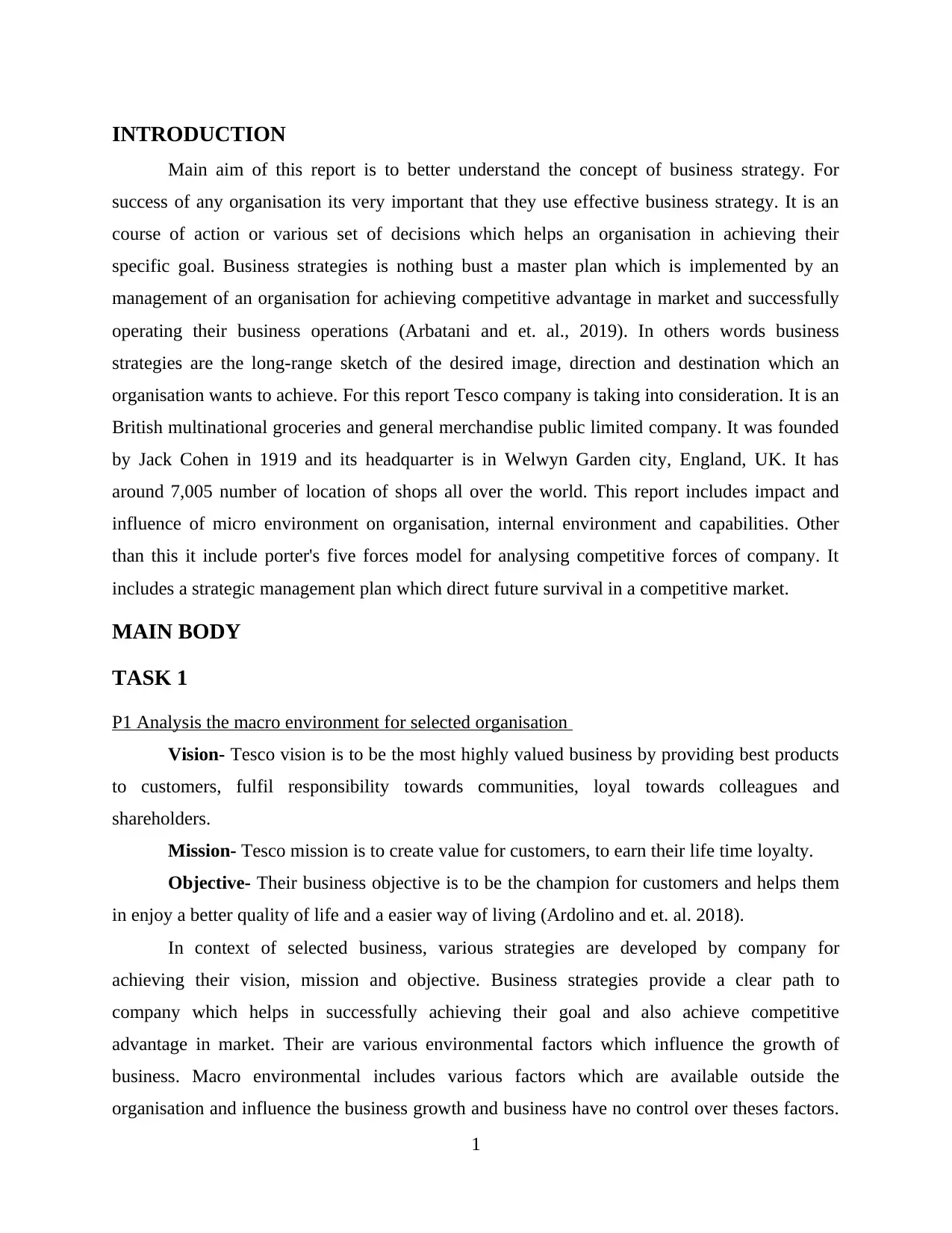
INTRODUCTION
Main aim of this report is to better understand the concept of business strategy. For
success of any organisation its very important that they use effective business strategy. It is an
course of action or various set of decisions which helps an organisation in achieving their
specific goal. Business strategies is nothing bust a master plan which is implemented by an
management of an organisation for achieving competitive advantage in market and successfully
operating their business operations (Arbatani and et. al., 2019). In others words business
strategies are the long-range sketch of the desired image, direction and destination which an
organisation wants to achieve. For this report Tesco company is taking into consideration. It is an
British multinational groceries and general merchandise public limited company. It was founded
by Jack Cohen in 1919 and its headquarter is in Welwyn Garden city, England, UK. It has
around 7,005 number of location of shops all over the world. This report includes impact and
influence of micro environment on organisation, internal environment and capabilities. Other
than this it include porter's five forces model for analysing competitive forces of company. It
includes a strategic management plan which direct future survival in a competitive market.
MAIN BODY
TASK 1
P1 Analysis the macro environment for selected organisation
Vision- Tesco vision is to be the most highly valued business by providing best products
to customers, fulfil responsibility towards communities, loyal towards colleagues and
shareholders.
Mission- Tesco mission is to create value for customers, to earn their life time loyalty.
Objective- Their business objective is to be the champion for customers and helps them
in enjoy a better quality of life and a easier way of living (Ardolino and et. al. 2018).
In context of selected business, various strategies are developed by company for
achieving their vision, mission and objective. Business strategies provide a clear path to
company which helps in successfully achieving their goal and also achieve competitive
advantage in market. Their are various environmental factors which influence the growth of
business. Macro environmental includes various factors which are available outside the
organisation and influence the business growth and business have no control over theses factors.
1
Main aim of this report is to better understand the concept of business strategy. For
success of any organisation its very important that they use effective business strategy. It is an
course of action or various set of decisions which helps an organisation in achieving their
specific goal. Business strategies is nothing bust a master plan which is implemented by an
management of an organisation for achieving competitive advantage in market and successfully
operating their business operations (Arbatani and et. al., 2019). In others words business
strategies are the long-range sketch of the desired image, direction and destination which an
organisation wants to achieve. For this report Tesco company is taking into consideration. It is an
British multinational groceries and general merchandise public limited company. It was founded
by Jack Cohen in 1919 and its headquarter is in Welwyn Garden city, England, UK. It has
around 7,005 number of location of shops all over the world. This report includes impact and
influence of micro environment on organisation, internal environment and capabilities. Other
than this it include porter's five forces model for analysing competitive forces of company. It
includes a strategic management plan which direct future survival in a competitive market.
MAIN BODY
TASK 1
P1 Analysis the macro environment for selected organisation
Vision- Tesco vision is to be the most highly valued business by providing best products
to customers, fulfil responsibility towards communities, loyal towards colleagues and
shareholders.
Mission- Tesco mission is to create value for customers, to earn their life time loyalty.
Objective- Their business objective is to be the champion for customers and helps them
in enjoy a better quality of life and a easier way of living (Ardolino and et. al. 2018).
In context of selected business, various strategies are developed by company for
achieving their vision, mission and objective. Business strategies provide a clear path to
company which helps in successfully achieving their goal and also achieve competitive
advantage in market. Their are various environmental factors which influence the growth of
business. Macro environmental includes various factors which are available outside the
organisation and influence the business growth and business have no control over theses factors.
1
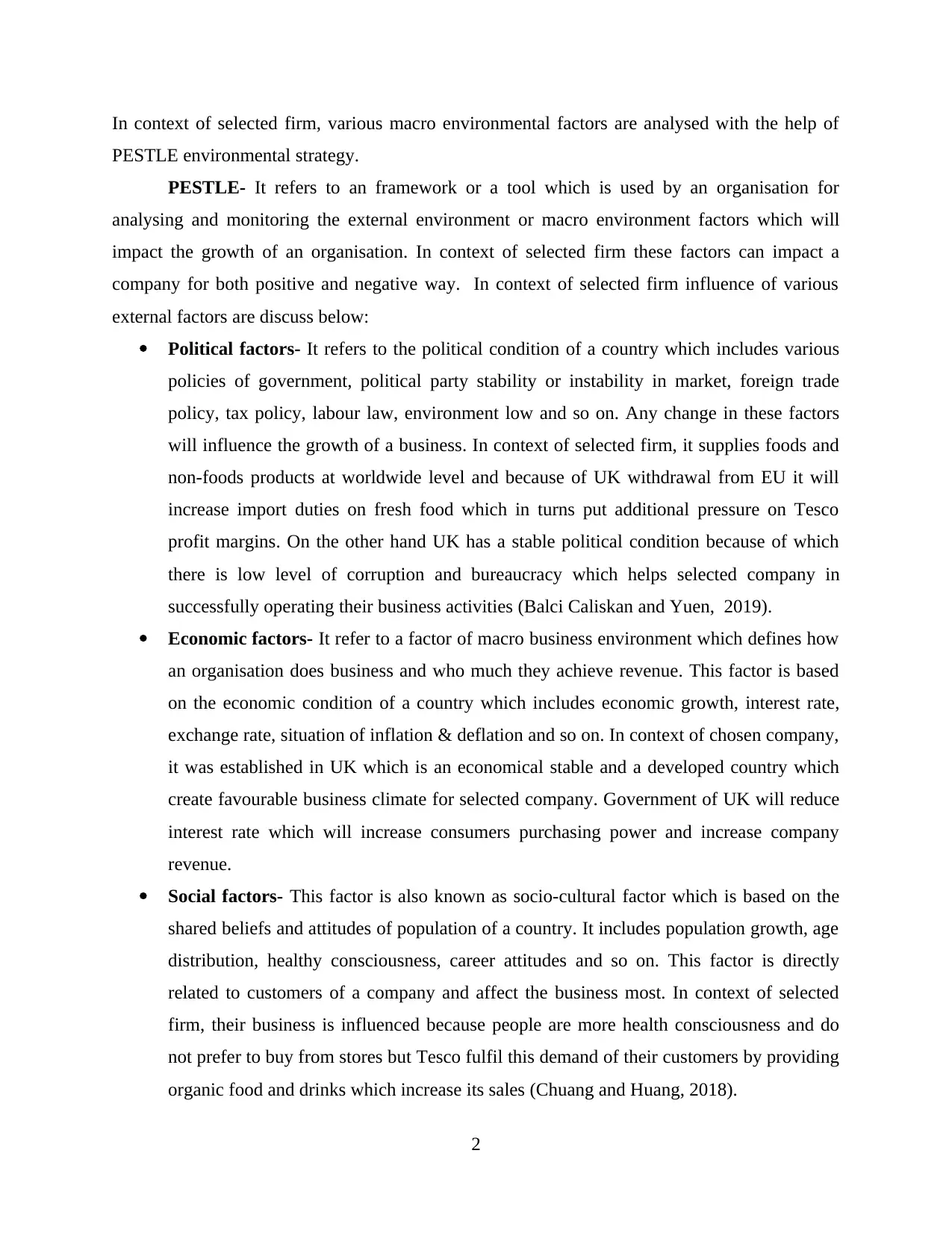
In context of selected firm, various macro environmental factors are analysed with the help of
PESTLE environmental strategy.
PESTLE- It refers to an framework or a tool which is used by an organisation for
analysing and monitoring the external environment or macro environment factors which will
impact the growth of an organisation. In context of selected firm these factors can impact a
company for both positive and negative way. In context of selected firm influence of various
external factors are discuss below:
Political factors- It refers to the political condition of a country which includes various
policies of government, political party stability or instability in market, foreign trade
policy, tax policy, labour law, environment low and so on. Any change in these factors
will influence the growth of a business. In context of selected firm, it supplies foods and
non-foods products at worldwide level and because of UK withdrawal from EU it will
increase import duties on fresh food which in turns put additional pressure on Tesco
profit margins. On the other hand UK has a stable political condition because of which
there is low level of corruption and bureaucracy which helps selected company in
successfully operating their business activities (Balci Caliskan and Yuen, 2019).
Economic factors- It refer to a factor of macro business environment which defines how
an organisation does business and who much they achieve revenue. This factor is based
on the economic condition of a country which includes economic growth, interest rate,
exchange rate, situation of inflation & deflation and so on. In context of chosen company,
it was established in UK which is an economical stable and a developed country which
create favourable business climate for selected company. Government of UK will reduce
interest rate which will increase consumers purchasing power and increase company
revenue.
Social factors- This factor is also known as socio-cultural factor which is based on the
shared beliefs and attitudes of population of a country. It includes population growth, age
distribution, healthy consciousness, career attitudes and so on. This factor is directly
related to customers of a company and affect the business most. In context of selected
firm, their business is influenced because people are more health consciousness and do
not prefer to buy from stores but Tesco fulfil this demand of their customers by providing
organic food and drinks which increase its sales (Chuang and Huang, 2018).
2
PESTLE environmental strategy.
PESTLE- It refers to an framework or a tool which is used by an organisation for
analysing and monitoring the external environment or macro environment factors which will
impact the growth of an organisation. In context of selected firm these factors can impact a
company for both positive and negative way. In context of selected firm influence of various
external factors are discuss below:
Political factors- It refers to the political condition of a country which includes various
policies of government, political party stability or instability in market, foreign trade
policy, tax policy, labour law, environment low and so on. Any change in these factors
will influence the growth of a business. In context of selected firm, it supplies foods and
non-foods products at worldwide level and because of UK withdrawal from EU it will
increase import duties on fresh food which in turns put additional pressure on Tesco
profit margins. On the other hand UK has a stable political condition because of which
there is low level of corruption and bureaucracy which helps selected company in
successfully operating their business activities (Balci Caliskan and Yuen, 2019).
Economic factors- It refer to a factor of macro business environment which defines how
an organisation does business and who much they achieve revenue. This factor is based
on the economic condition of a country which includes economic growth, interest rate,
exchange rate, situation of inflation & deflation and so on. In context of chosen company,
it was established in UK which is an economical stable and a developed country which
create favourable business climate for selected company. Government of UK will reduce
interest rate which will increase consumers purchasing power and increase company
revenue.
Social factors- This factor is also known as socio-cultural factor which is based on the
shared beliefs and attitudes of population of a country. It includes population growth, age
distribution, healthy consciousness, career attitudes and so on. This factor is directly
related to customers of a company and affect the business most. In context of selected
firm, their business is influenced because people are more health consciousness and do
not prefer to buy from stores but Tesco fulfil this demand of their customers by providing
organic food and drinks which increase its sales (Chuang and Huang, 2018).
2
Secure Best Marks with AI Grader
Need help grading? Try our AI Grader for instant feedback on your assignments.
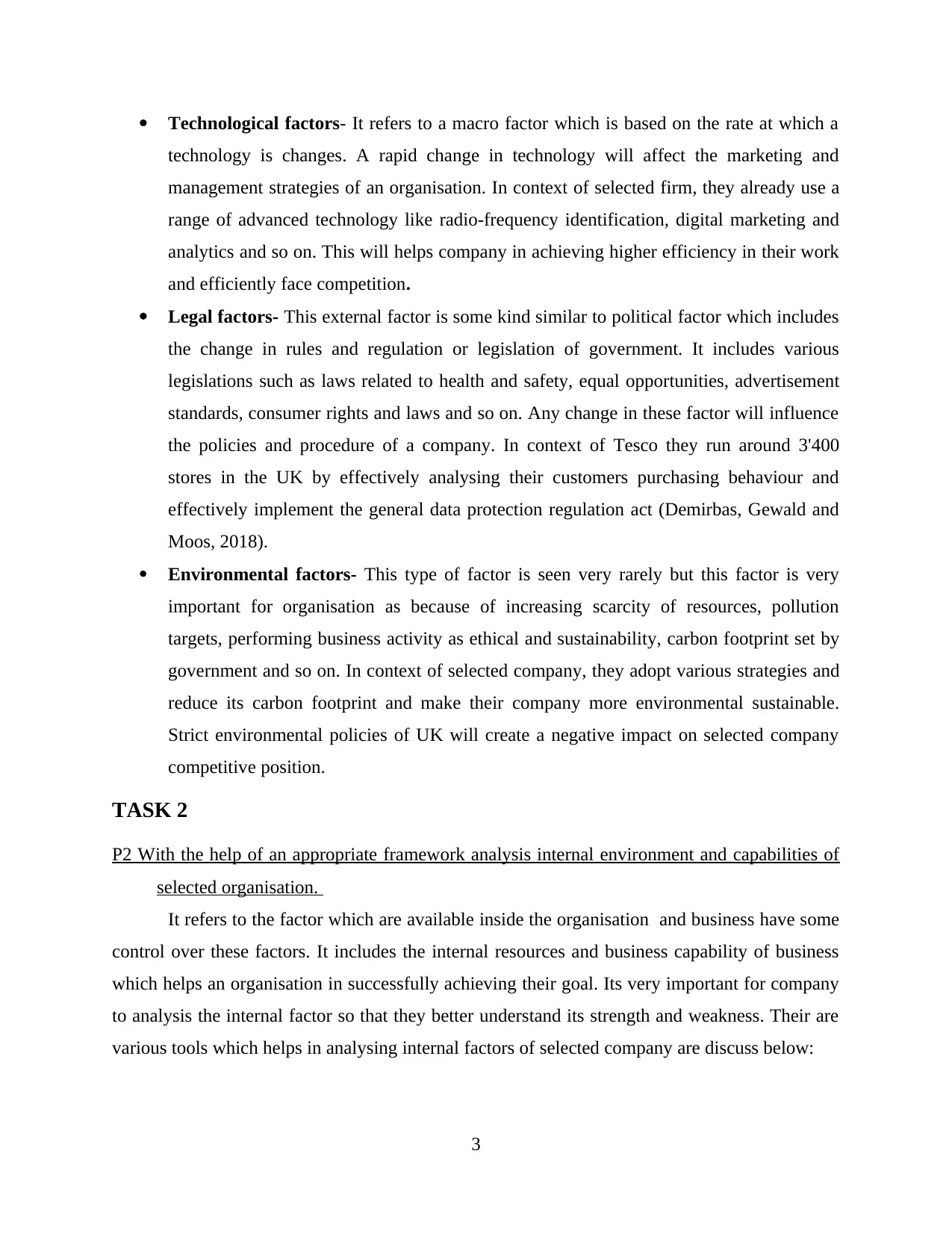
Technological factors- It refers to a macro factor which is based on the rate at which a
technology is changes. A rapid change in technology will affect the marketing and
management strategies of an organisation. In context of selected firm, they already use a
range of advanced technology like radio-frequency identification, digital marketing and
analytics and so on. This will helps company in achieving higher efficiency in their work
and efficiently face competition.
Legal factors- This external factor is some kind similar to political factor which includes
the change in rules and regulation or legislation of government. It includes various
legislations such as laws related to health and safety, equal opportunities, advertisement
standards, consumer rights and laws and so on. Any change in these factor will influence
the policies and procedure of a company. In context of Tesco they run around 3'400
stores in the UK by effectively analysing their customers purchasing behaviour and
effectively implement the general data protection regulation act (Demirbas, Gewald and
Moos, 2018).
Environmental factors- This type of factor is seen very rarely but this factor is very
important for organisation as because of increasing scarcity of resources, pollution
targets, performing business activity as ethical and sustainability, carbon footprint set by
government and so on. In context of selected company, they adopt various strategies and
reduce its carbon footprint and make their company more environmental sustainable.
Strict environmental policies of UK will create a negative impact on selected company
competitive position.
TASK 2
P2 With the help of an appropriate framework analysis internal environment and capabilities of
selected organisation.
It refers to the factor which are available inside the organisation and business have some
control over these factors. It includes the internal resources and business capability of business
which helps an organisation in successfully achieving their goal. Its very important for company
to analysis the internal factor so that they better understand its strength and weakness. Their are
various tools which helps in analysing internal factors of selected company are discuss below:
3
technology is changes. A rapid change in technology will affect the marketing and
management strategies of an organisation. In context of selected firm, they already use a
range of advanced technology like radio-frequency identification, digital marketing and
analytics and so on. This will helps company in achieving higher efficiency in their work
and efficiently face competition.
Legal factors- This external factor is some kind similar to political factor which includes
the change in rules and regulation or legislation of government. It includes various
legislations such as laws related to health and safety, equal opportunities, advertisement
standards, consumer rights and laws and so on. Any change in these factor will influence
the policies and procedure of a company. In context of Tesco they run around 3'400
stores in the UK by effectively analysing their customers purchasing behaviour and
effectively implement the general data protection regulation act (Demirbas, Gewald and
Moos, 2018).
Environmental factors- This type of factor is seen very rarely but this factor is very
important for organisation as because of increasing scarcity of resources, pollution
targets, performing business activity as ethical and sustainability, carbon footprint set by
government and so on. In context of selected company, they adopt various strategies and
reduce its carbon footprint and make their company more environmental sustainable.
Strict environmental policies of UK will create a negative impact on selected company
competitive position.
TASK 2
P2 With the help of an appropriate framework analysis internal environment and capabilities of
selected organisation.
It refers to the factor which are available inside the organisation and business have some
control over these factors. It includes the internal resources and business capability of business
which helps an organisation in successfully achieving their goal. Its very important for company
to analysis the internal factor so that they better understand its strength and weakness. Their are
various tools which helps in analysing internal factors of selected company are discuss below:
3
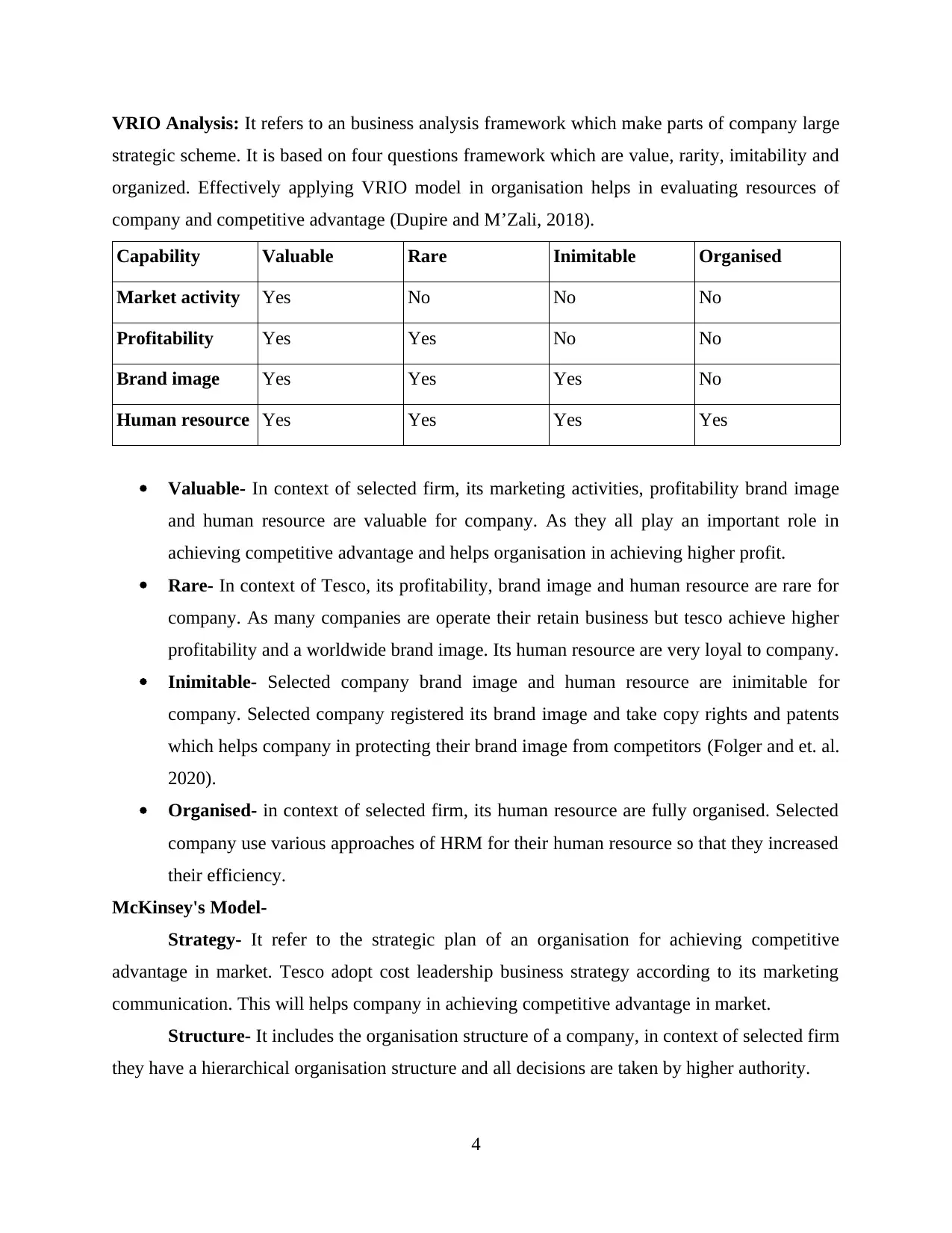
VRIO Analysis: It refers to an business analysis framework which make parts of company large
strategic scheme. It is based on four questions framework which are value, rarity, imitability and
organized. Effectively applying VRIO model in organisation helps in evaluating resources of
company and competitive advantage (Dupire and M’Zali, 2018).
Capability Valuable Rare Inimitable Organised
Market activity Yes No No No
Profitability Yes Yes No No
Brand image Yes Yes Yes No
Human resource Yes Yes Yes Yes
Valuable- In context of selected firm, its marketing activities, profitability brand image
and human resource are valuable for company. As they all play an important role in
achieving competitive advantage and helps organisation in achieving higher profit.
Rare- In context of Tesco, its profitability, brand image and human resource are rare for
company. As many companies are operate their retain business but tesco achieve higher
profitability and a worldwide brand image. Its human resource are very loyal to company.
Inimitable- Selected company brand image and human resource are inimitable for
company. Selected company registered its brand image and take copy rights and patents
which helps company in protecting their brand image from competitors (Folger and et. al.
2020).
Organised- in context of selected firm, its human resource are fully organised. Selected
company use various approaches of HRM for their human resource so that they increased
their efficiency.
McKinsey's Model-
Strategy- It refer to the strategic plan of an organisation for achieving competitive
advantage in market. Tesco adopt cost leadership business strategy according to its marketing
communication. This will helps company in achieving competitive advantage in market.
Structure- It includes the organisation structure of a company, in context of selected firm
they have a hierarchical organisation structure and all decisions are taken by higher authority.
4
strategic scheme. It is based on four questions framework which are value, rarity, imitability and
organized. Effectively applying VRIO model in organisation helps in evaluating resources of
company and competitive advantage (Dupire and M’Zali, 2018).
Capability Valuable Rare Inimitable Organised
Market activity Yes No No No
Profitability Yes Yes No No
Brand image Yes Yes Yes No
Human resource Yes Yes Yes Yes
Valuable- In context of selected firm, its marketing activities, profitability brand image
and human resource are valuable for company. As they all play an important role in
achieving competitive advantage and helps organisation in achieving higher profit.
Rare- In context of Tesco, its profitability, brand image and human resource are rare for
company. As many companies are operate their retain business but tesco achieve higher
profitability and a worldwide brand image. Its human resource are very loyal to company.
Inimitable- Selected company brand image and human resource are inimitable for
company. Selected company registered its brand image and take copy rights and patents
which helps company in protecting their brand image from competitors (Folger and et. al.
2020).
Organised- in context of selected firm, its human resource are fully organised. Selected
company use various approaches of HRM for their human resource so that they increased
their efficiency.
McKinsey's Model-
Strategy- It refer to the strategic plan of an organisation for achieving competitive
advantage in market. Tesco adopt cost leadership business strategy according to its marketing
communication. This will helps company in achieving competitive advantage in market.
Structure- It includes the organisation structure of a company, in context of selected firm
they have a hierarchical organisation structure and all decisions are taken by higher authority.
4
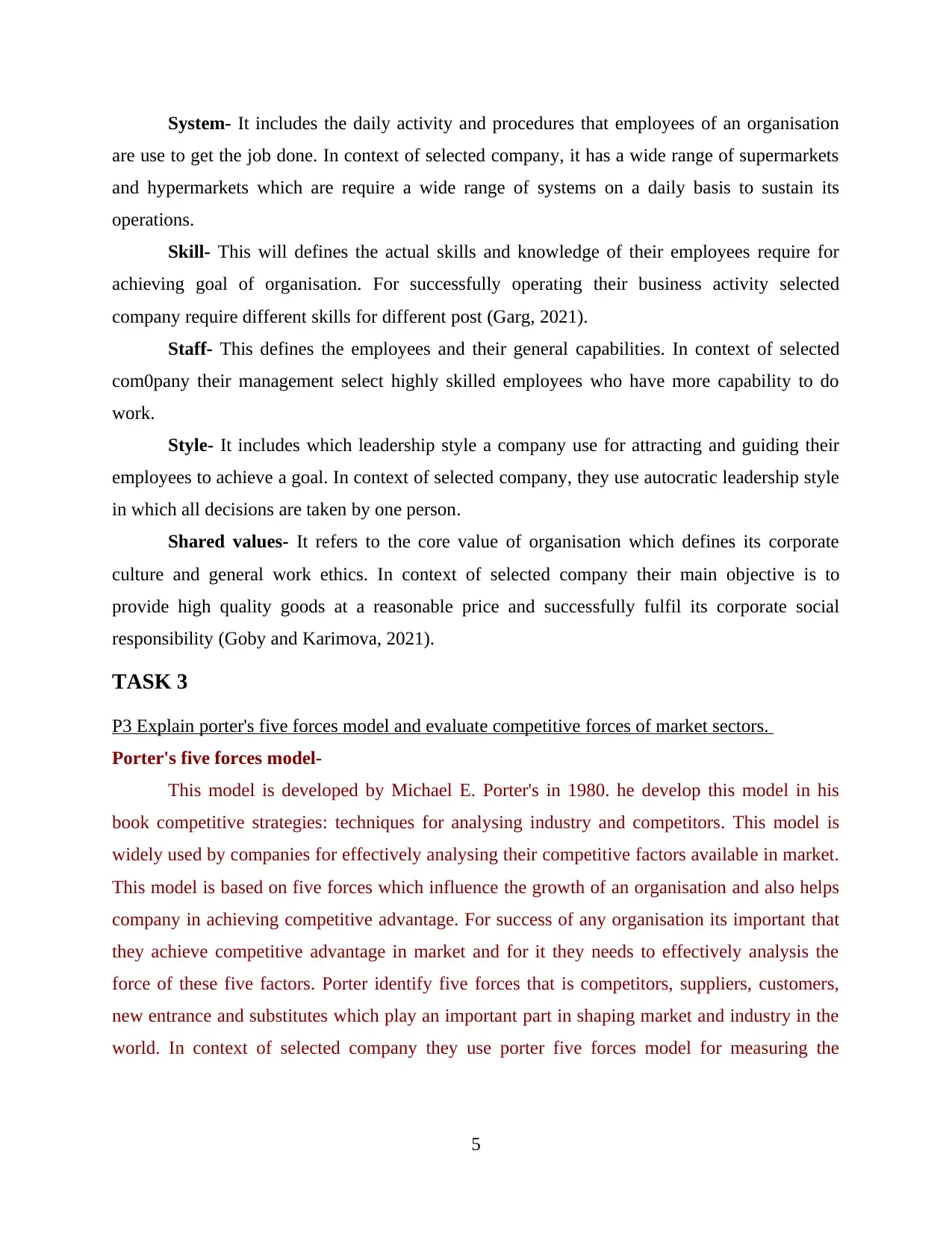
System- It includes the daily activity and procedures that employees of an organisation
are use to get the job done. In context of selected company, it has a wide range of supermarkets
and hypermarkets which are require a wide range of systems on a daily basis to sustain its
operations.
Skill- This will defines the actual skills and knowledge of their employees require for
achieving goal of organisation. For successfully operating their business activity selected
company require different skills for different post (Garg, 2021).
Staff- This defines the employees and their general capabilities. In context of selected
com0pany their management select highly skilled employees who have more capability to do
work.
Style- It includes which leadership style a company use for attracting and guiding their
employees to achieve a goal. In context of selected company, they use autocratic leadership style
in which all decisions are taken by one person.
Shared values- It refers to the core value of organisation which defines its corporate
culture and general work ethics. In context of selected company their main objective is to
provide high quality goods at a reasonable price and successfully fulfil its corporate social
responsibility (Goby and Karimova, 2021).
TASK 3
P3 Explain porter's five forces model and evaluate competitive forces of market sectors.
Porter's five forces model-
This model is developed by Michael E. Porter's in 1980. he develop this model in his
book competitive strategies: techniques for analysing industry and competitors. This model is
widely used by companies for effectively analysing their competitive factors available in market.
This model is based on five forces which influence the growth of an organisation and also helps
company in achieving competitive advantage. For success of any organisation its important that
they achieve competitive advantage in market and for it they needs to effectively analysis the
force of these five factors. Porter identify five forces that is competitors, suppliers, customers,
new entrance and substitutes which play an important part in shaping market and industry in the
world. In context of selected company they use porter five forces model for measuring the
5
are use to get the job done. In context of selected company, it has a wide range of supermarkets
and hypermarkets which are require a wide range of systems on a daily basis to sustain its
operations.
Skill- This will defines the actual skills and knowledge of their employees require for
achieving goal of organisation. For successfully operating their business activity selected
company require different skills for different post (Garg, 2021).
Staff- This defines the employees and their general capabilities. In context of selected
com0pany their management select highly skilled employees who have more capability to do
work.
Style- It includes which leadership style a company use for attracting and guiding their
employees to achieve a goal. In context of selected company, they use autocratic leadership style
in which all decisions are taken by one person.
Shared values- It refers to the core value of organisation which defines its corporate
culture and general work ethics. In context of selected company their main objective is to
provide high quality goods at a reasonable price and successfully fulfil its corporate social
responsibility (Goby and Karimova, 2021).
TASK 3
P3 Explain porter's five forces model and evaluate competitive forces of market sectors.
Porter's five forces model-
This model is developed by Michael E. Porter's in 1980. he develop this model in his
book competitive strategies: techniques for analysing industry and competitors. This model is
widely used by companies for effectively analysing their competitive factors available in market.
This model is based on five forces which influence the growth of an organisation and also helps
company in achieving competitive advantage. For success of any organisation its important that
they achieve competitive advantage in market and for it they needs to effectively analysis the
force of these five factors. Porter identify five forces that is competitors, suppliers, customers,
new entrance and substitutes which play an important part in shaping market and industry in the
world. In context of selected company they use porter five forces model for measuring the
5
Paraphrase This Document
Need a fresh take? Get an instant paraphrase of this document with our AI Paraphraser
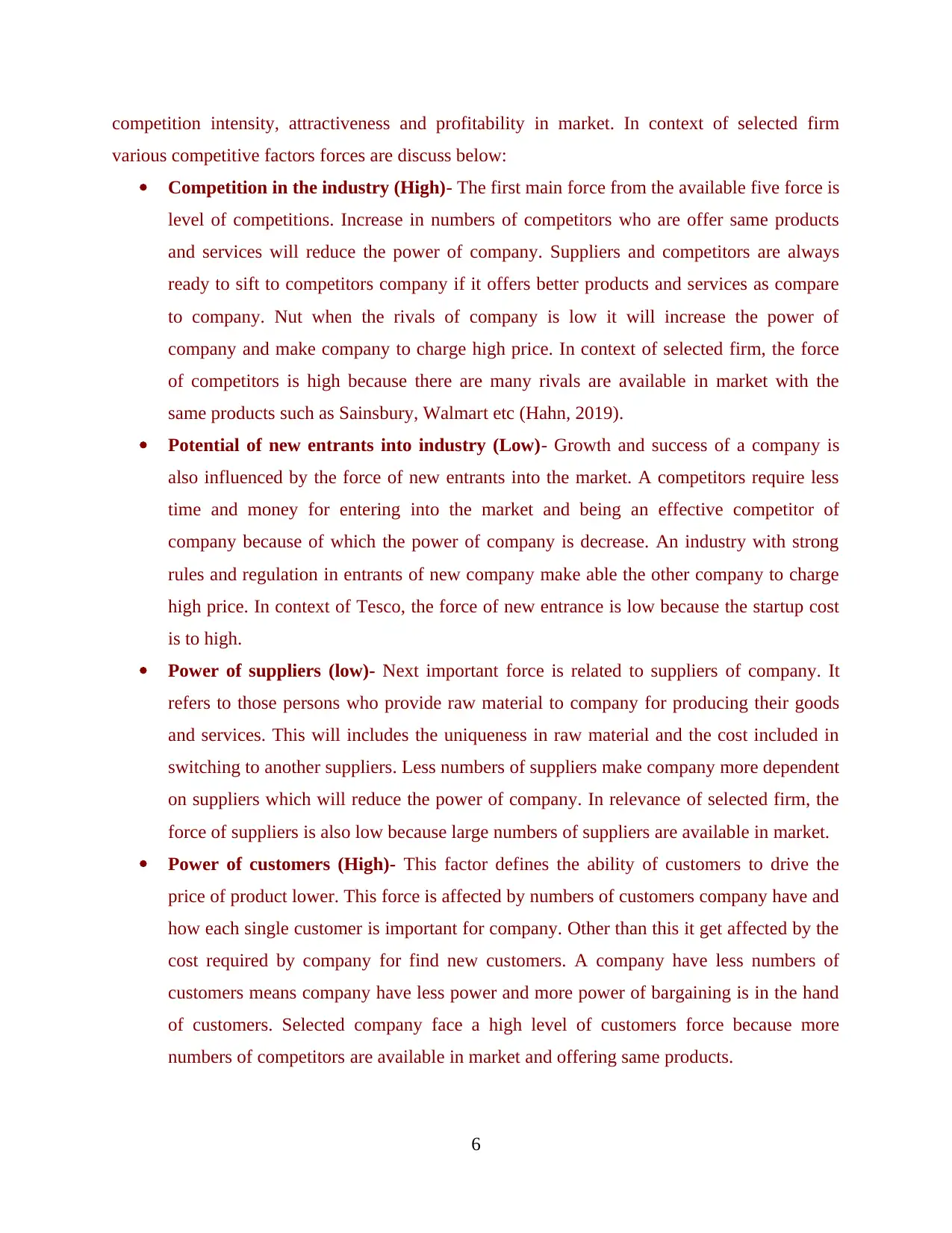
competition intensity, attractiveness and profitability in market. In context of selected firm
various competitive factors forces are discuss below:
Competition in the industry (High)- The first main force from the available five force is
level of competitions. Increase in numbers of competitors who are offer same products
and services will reduce the power of company. Suppliers and competitors are always
ready to sift to competitors company if it offers better products and services as compare
to company. Nut when the rivals of company is low it will increase the power of
company and make company to charge high price. In context of selected firm, the force
of competitors is high because there are many rivals are available in market with the
same products such as Sainsbury, Walmart etc (Hahn, 2019).
Potential of new entrants into industry (Low)- Growth and success of a company is
also influenced by the force of new entrants into the market. A competitors require less
time and money for entering into the market and being an effective competitor of
company because of which the power of company is decrease. An industry with strong
rules and regulation in entrants of new company make able the other company to charge
high price. In context of Tesco, the force of new entrance is low because the startup cost
is to high.
Power of suppliers (low)- Next important force is related to suppliers of company. It
refers to those persons who provide raw material to company for producing their goods
and services. This will includes the uniqueness in raw material and the cost included in
switching to another suppliers. Less numbers of suppliers make company more dependent
on suppliers which will reduce the power of company. In relevance of selected firm, the
force of suppliers is also low because large numbers of suppliers are available in market.
Power of customers (High)- This factor defines the ability of customers to drive the
price of product lower. This force is affected by numbers of customers company have and
how each single customer is important for company. Other than this it get affected by the
cost required by company for find new customers. A company have less numbers of
customers means company have less power and more power of bargaining is in the hand
of customers. Selected company face a high level of customers force because more
numbers of competitors are available in market and offering same products.
6
various competitive factors forces are discuss below:
Competition in the industry (High)- The first main force from the available five force is
level of competitions. Increase in numbers of competitors who are offer same products
and services will reduce the power of company. Suppliers and competitors are always
ready to sift to competitors company if it offers better products and services as compare
to company. Nut when the rivals of company is low it will increase the power of
company and make company to charge high price. In context of selected firm, the force
of competitors is high because there are many rivals are available in market with the
same products such as Sainsbury, Walmart etc (Hahn, 2019).
Potential of new entrants into industry (Low)- Growth and success of a company is
also influenced by the force of new entrants into the market. A competitors require less
time and money for entering into the market and being an effective competitor of
company because of which the power of company is decrease. An industry with strong
rules and regulation in entrants of new company make able the other company to charge
high price. In context of Tesco, the force of new entrance is low because the startup cost
is to high.
Power of suppliers (low)- Next important force is related to suppliers of company. It
refers to those persons who provide raw material to company for producing their goods
and services. This will includes the uniqueness in raw material and the cost included in
switching to another suppliers. Less numbers of suppliers make company more dependent
on suppliers which will reduce the power of company. In relevance of selected firm, the
force of suppliers is also low because large numbers of suppliers are available in market.
Power of customers (High)- This factor defines the ability of customers to drive the
price of product lower. This force is affected by numbers of customers company have and
how each single customer is important for company. Other than this it get affected by the
cost required by company for find new customers. A company have less numbers of
customers means company have less power and more power of bargaining is in the hand
of customers. Selected company face a high level of customers force because more
numbers of competitors are available in market and offering same products.
6
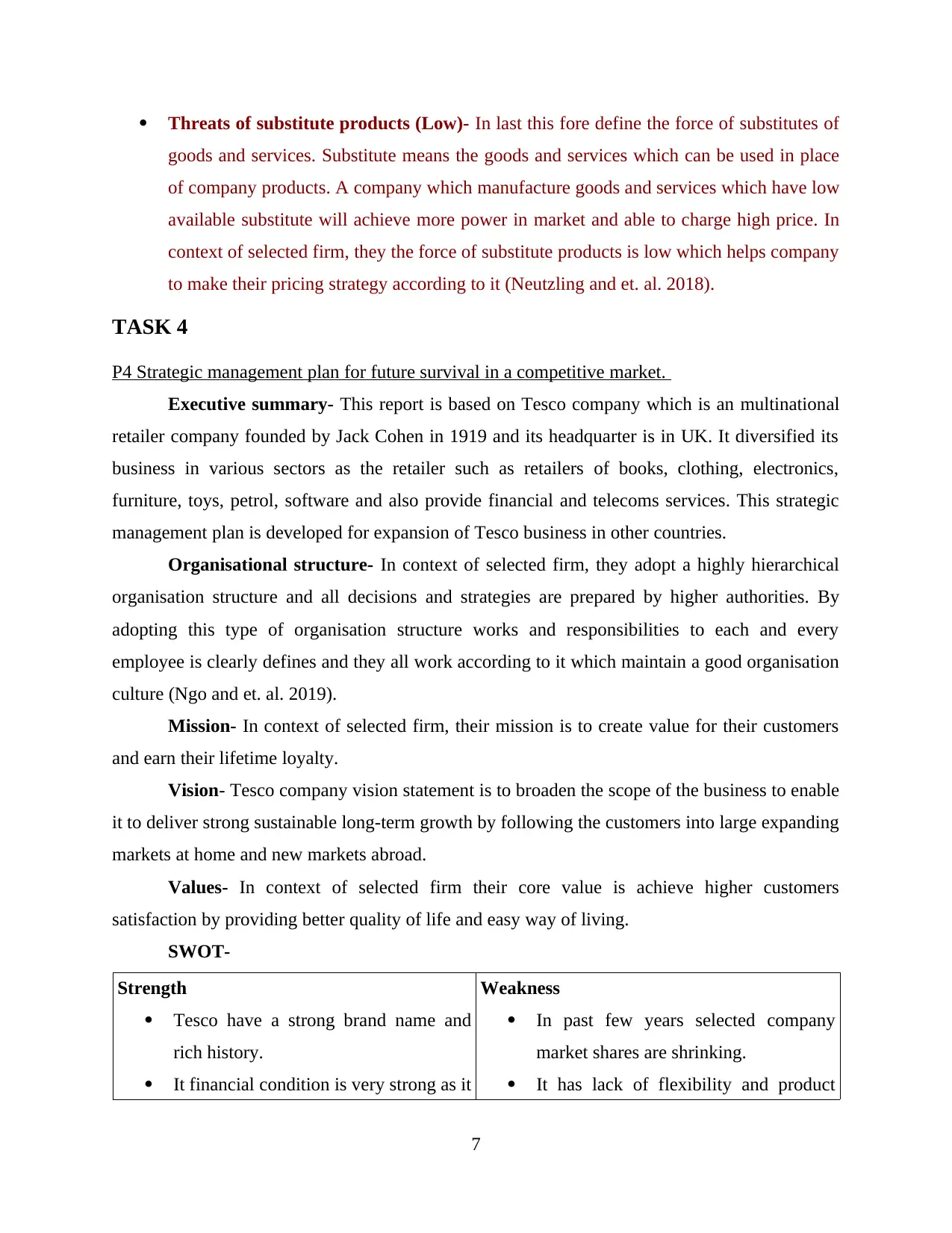
Threats of substitute products (Low)- In last this fore define the force of substitutes of
goods and services. Substitute means the goods and services which can be used in place
of company products. A company which manufacture goods and services which have low
available substitute will achieve more power in market and able to charge high price. In
context of selected firm, they the force of substitute products is low which helps company
to make their pricing strategy according to it (Neutzling and et. al. 2018).
TASK 4
P4 Strategic management plan for future survival in a competitive market.
Executive summary- This report is based on Tesco company which is an multinational
retailer company founded by Jack Cohen in 1919 and its headquarter is in UK. It diversified its
business in various sectors as the retailer such as retailers of books, clothing, electronics,
furniture, toys, petrol, software and also provide financial and telecoms services. This strategic
management plan is developed for expansion of Tesco business in other countries.
Organisational structure- In context of selected firm, they adopt a highly hierarchical
organisation structure and all decisions and strategies are prepared by higher authorities. By
adopting this type of organisation structure works and responsibilities to each and every
employee is clearly defines and they all work according to it which maintain a good organisation
culture (Ngo and et. al. 2019).
Mission- In context of selected firm, their mission is to create value for their customers
and earn their lifetime loyalty.
Vision- Tesco company vision statement is to broaden the scope of the business to enable
it to deliver strong sustainable long-term growth by following the customers into large expanding
markets at home and new markets abroad.
Values- In context of selected firm their core value is achieve higher customers
satisfaction by providing better quality of life and easy way of living.
SWOT-
Strength
Tesco have a strong brand name and
rich history.
It financial condition is very strong as it
Weakness
In past few years selected company
market shares are shrinking.
It has lack of flexibility and product
7
goods and services. Substitute means the goods and services which can be used in place
of company products. A company which manufacture goods and services which have low
available substitute will achieve more power in market and able to charge high price. In
context of selected firm, they the force of substitute products is low which helps company
to make their pricing strategy according to it (Neutzling and et. al. 2018).
TASK 4
P4 Strategic management plan for future survival in a competitive market.
Executive summary- This report is based on Tesco company which is an multinational
retailer company founded by Jack Cohen in 1919 and its headquarter is in UK. It diversified its
business in various sectors as the retailer such as retailers of books, clothing, electronics,
furniture, toys, petrol, software and also provide financial and telecoms services. This strategic
management plan is developed for expansion of Tesco business in other countries.
Organisational structure- In context of selected firm, they adopt a highly hierarchical
organisation structure and all decisions and strategies are prepared by higher authorities. By
adopting this type of organisation structure works and responsibilities to each and every
employee is clearly defines and they all work according to it which maintain a good organisation
culture (Ngo and et. al. 2019).
Mission- In context of selected firm, their mission is to create value for their customers
and earn their lifetime loyalty.
Vision- Tesco company vision statement is to broaden the scope of the business to enable
it to deliver strong sustainable long-term growth by following the customers into large expanding
markets at home and new markets abroad.
Values- In context of selected firm their core value is achieve higher customers
satisfaction by providing better quality of life and easy way of living.
SWOT-
Strength
Tesco have a strong brand name and
rich history.
It financial condition is very strong as it
Weakness
In past few years selected company
market shares are shrinking.
It has lack of flexibility and product
7
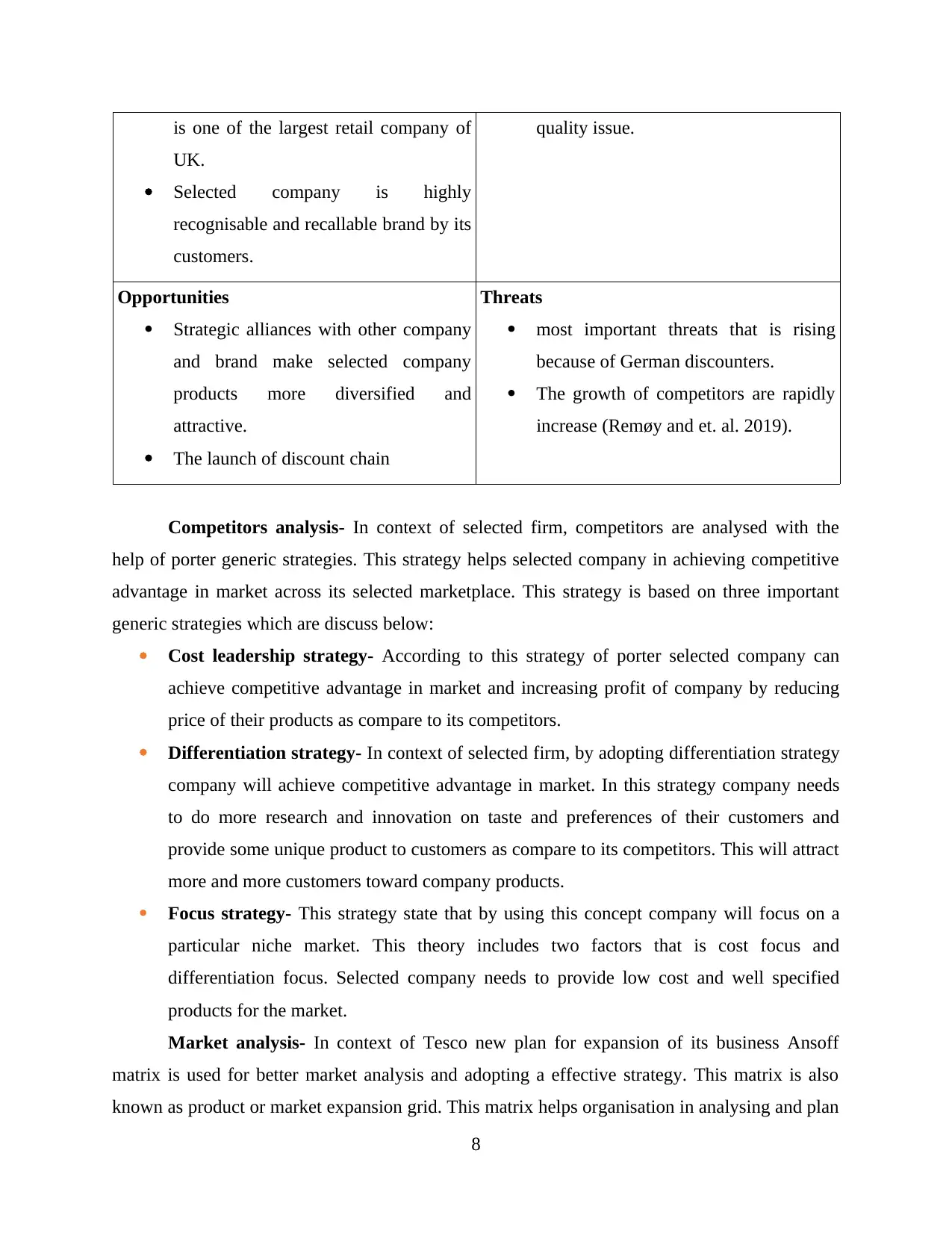
is one of the largest retail company of
UK.
Selected company is highly
recognisable and recallable brand by its
customers.
quality issue.
Opportunities
Strategic alliances with other company
and brand make selected company
products more diversified and
attractive.
The launch of discount chain
Threats
most important threats that is rising
because of German discounters.
The growth of competitors are rapidly
increase (Remøy and et. al. 2019).
Competitors analysis- In context of selected firm, competitors are analysed with the
help of porter generic strategies. This strategy helps selected company in achieving competitive
advantage in market across its selected marketplace. This strategy is based on three important
generic strategies which are discuss below:
Cost leadership strategy- According to this strategy of porter selected company can
achieve competitive advantage in market and increasing profit of company by reducing
price of their products as compare to its competitors.
Differentiation strategy- In context of selected firm, by adopting differentiation strategy
company will achieve competitive advantage in market. In this strategy company needs
to do more research and innovation on taste and preferences of their customers and
provide some unique product to customers as compare to its competitors. This will attract
more and more customers toward company products.
Focus strategy- This strategy state that by using this concept company will focus on a
particular niche market. This theory includes two factors that is cost focus and
differentiation focus. Selected company needs to provide low cost and well specified
products for the market.
Market analysis- In context of Tesco new plan for expansion of its business Ansoff
matrix is used for better market analysis and adopting a effective strategy. This matrix is also
known as product or market expansion grid. This matrix helps organisation in analysing and plan
8
UK.
Selected company is highly
recognisable and recallable brand by its
customers.
quality issue.
Opportunities
Strategic alliances with other company
and brand make selected company
products more diversified and
attractive.
The launch of discount chain
Threats
most important threats that is rising
because of German discounters.
The growth of competitors are rapidly
increase (Remøy and et. al. 2019).
Competitors analysis- In context of selected firm, competitors are analysed with the
help of porter generic strategies. This strategy helps selected company in achieving competitive
advantage in market across its selected marketplace. This strategy is based on three important
generic strategies which are discuss below:
Cost leadership strategy- According to this strategy of porter selected company can
achieve competitive advantage in market and increasing profit of company by reducing
price of their products as compare to its competitors.
Differentiation strategy- In context of selected firm, by adopting differentiation strategy
company will achieve competitive advantage in market. In this strategy company needs
to do more research and innovation on taste and preferences of their customers and
provide some unique product to customers as compare to its competitors. This will attract
more and more customers toward company products.
Focus strategy- This strategy state that by using this concept company will focus on a
particular niche market. This theory includes two factors that is cost focus and
differentiation focus. Selected company needs to provide low cost and well specified
products for the market.
Market analysis- In context of Tesco new plan for expansion of its business Ansoff
matrix is used for better market analysis and adopting a effective strategy. This matrix is also
known as product or market expansion grid. This matrix helps organisation in analysing and plan
8
Secure Best Marks with AI Grader
Need help grading? Try our AI Grader for instant feedback on your assignments.
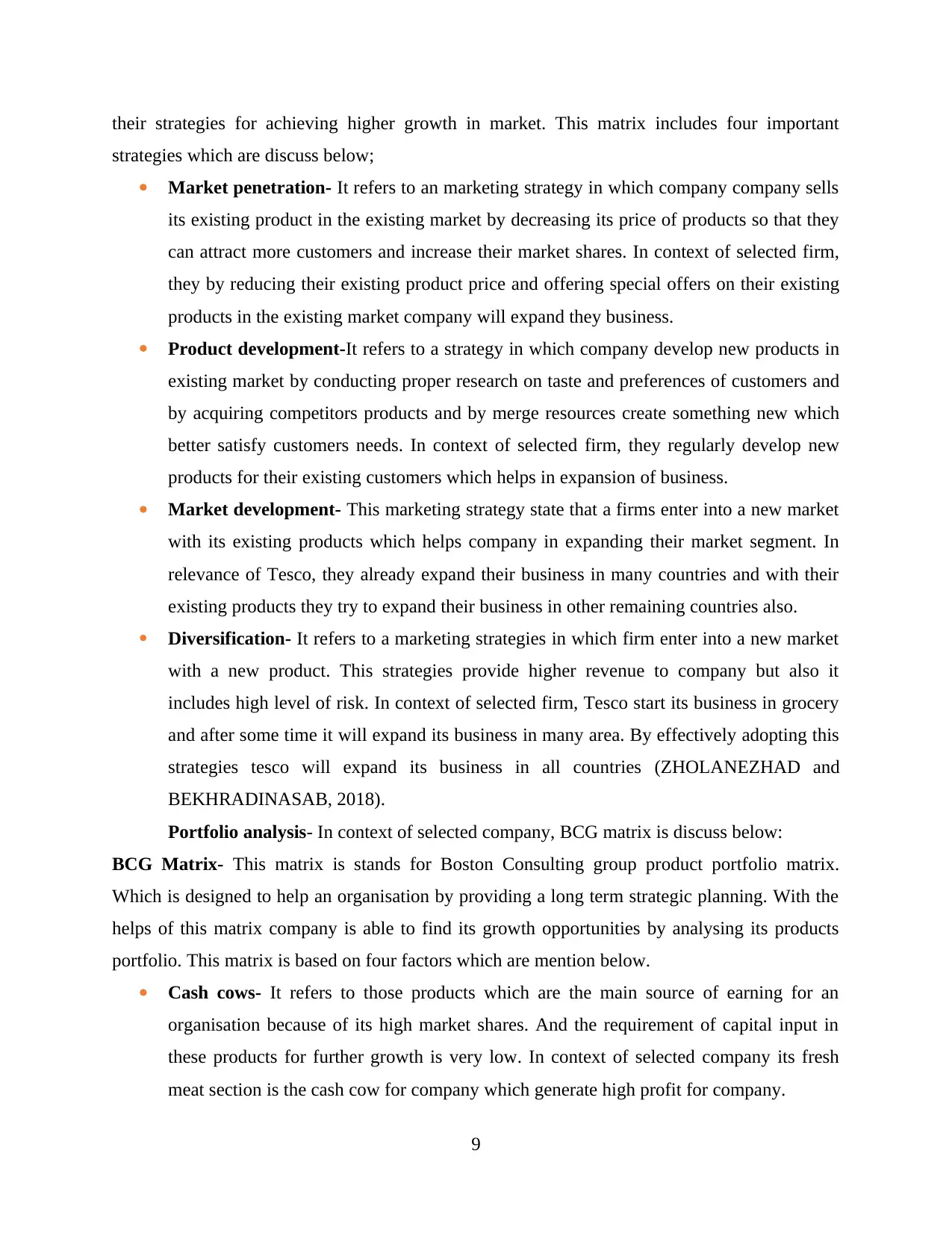
their strategies for achieving higher growth in market. This matrix includes four important
strategies which are discuss below;
Market penetration- It refers to an marketing strategy in which company company sells
its existing product in the existing market by decreasing its price of products so that they
can attract more customers and increase their market shares. In context of selected firm,
they by reducing their existing product price and offering special offers on their existing
products in the existing market company will expand they business.
Product development-It refers to a strategy in which company develop new products in
existing market by conducting proper research on taste and preferences of customers and
by acquiring competitors products and by merge resources create something new which
better satisfy customers needs. In context of selected firm, they regularly develop new
products for their existing customers which helps in expansion of business.
Market development- This marketing strategy state that a firms enter into a new market
with its existing products which helps company in expanding their market segment. In
relevance of Tesco, they already expand their business in many countries and with their
existing products they try to expand their business in other remaining countries also.
Diversification- It refers to a marketing strategies in which firm enter into a new market
with a new product. This strategies provide higher revenue to company but also it
includes high level of risk. In context of selected firm, Tesco start its business in grocery
and after some time it will expand its business in many area. By effectively adopting this
strategies tesco will expand its business in all countries (ZHOLANEZHAD and
BEKHRADINASAB, 2018).
Portfolio analysis- In context of selected company, BCG matrix is discuss below:
BCG Matrix- This matrix is stands for Boston Consulting group product portfolio matrix.
Which is designed to help an organisation by providing a long term strategic planning. With the
helps of this matrix company is able to find its growth opportunities by analysing its products
portfolio. This matrix is based on four factors which are mention below.
Cash cows- It refers to those products which are the main source of earning for an
organisation because of its high market shares. And the requirement of capital input in
these products for further growth is very low. In context of selected company its fresh
meat section is the cash cow for company which generate high profit for company.
9
strategies which are discuss below;
Market penetration- It refers to an marketing strategy in which company company sells
its existing product in the existing market by decreasing its price of products so that they
can attract more customers and increase their market shares. In context of selected firm,
they by reducing their existing product price and offering special offers on their existing
products in the existing market company will expand they business.
Product development-It refers to a strategy in which company develop new products in
existing market by conducting proper research on taste and preferences of customers and
by acquiring competitors products and by merge resources create something new which
better satisfy customers needs. In context of selected firm, they regularly develop new
products for their existing customers which helps in expansion of business.
Market development- This marketing strategy state that a firms enter into a new market
with its existing products which helps company in expanding their market segment. In
relevance of Tesco, they already expand their business in many countries and with their
existing products they try to expand their business in other remaining countries also.
Diversification- It refers to a marketing strategies in which firm enter into a new market
with a new product. This strategies provide higher revenue to company but also it
includes high level of risk. In context of selected firm, Tesco start its business in grocery
and after some time it will expand its business in many area. By effectively adopting this
strategies tesco will expand its business in all countries (ZHOLANEZHAD and
BEKHRADINASAB, 2018).
Portfolio analysis- In context of selected company, BCG matrix is discuss below:
BCG Matrix- This matrix is stands for Boston Consulting group product portfolio matrix.
Which is designed to help an organisation by providing a long term strategic planning. With the
helps of this matrix company is able to find its growth opportunities by analysing its products
portfolio. This matrix is based on four factors which are mention below.
Cash cows- It refers to those products which are the main source of earning for an
organisation because of its high market shares. And the requirement of capital input in
these products for further growth is very low. In context of selected company its fresh
meat section is the cash cow for company which generate high profit for company.
9
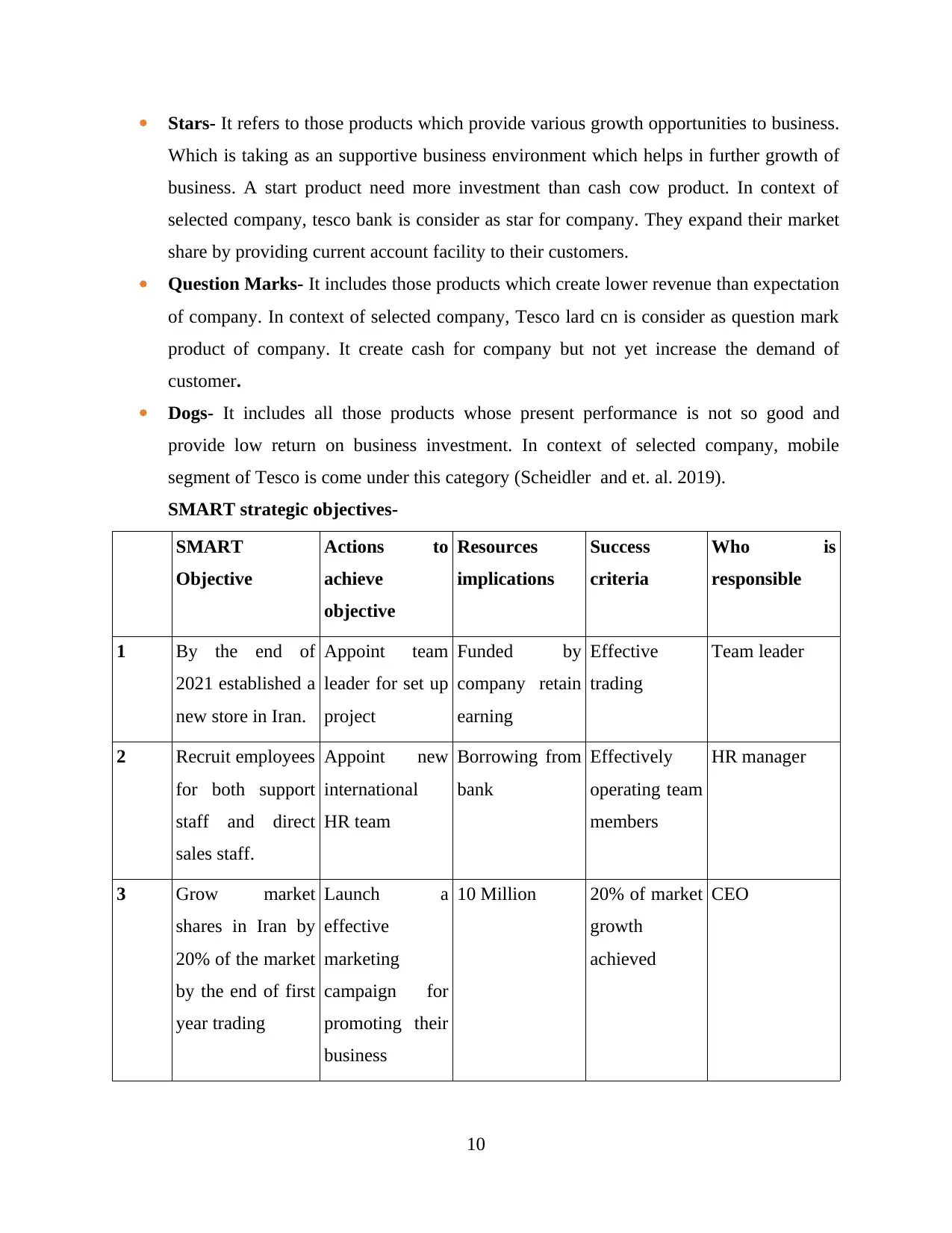
Stars- It refers to those products which provide various growth opportunities to business.
Which is taking as an supportive business environment which helps in further growth of
business. A start product need more investment than cash cow product. In context of
selected company, tesco bank is consider as star for company. They expand their market
share by providing current account facility to their customers.
Question Marks- It includes those products which create lower revenue than expectation
of company. In context of selected company, Tesco lard cn is consider as question mark
product of company. It create cash for company but not yet increase the demand of
customer.
Dogs- It includes all those products whose present performance is not so good and
provide low return on business investment. In context of selected company, mobile
segment of Tesco is come under this category (Scheidler and et. al. 2019).
SMART strategic objectives-
SMART
Objective
Actions to
achieve
objective
Resources
implications
Success
criteria
Who is
responsible
1 By the end of
2021 established a
new store in Iran.
Appoint team
leader for set up
project
Funded by
company retain
earning
Effective
trading
Team leader
2 Recruit employees
for both support
staff and direct
sales staff.
Appoint new
international
HR team
Borrowing from
bank
Effectively
operating team
members
HR manager
3 Grow market
shares in Iran by
20% of the market
by the end of first
year trading
Launch a
effective
marketing
campaign for
promoting their
business
10 Million 20% of market
growth
achieved
CEO
10
Which is taking as an supportive business environment which helps in further growth of
business. A start product need more investment than cash cow product. In context of
selected company, tesco bank is consider as star for company. They expand their market
share by providing current account facility to their customers.
Question Marks- It includes those products which create lower revenue than expectation
of company. In context of selected company, Tesco lard cn is consider as question mark
product of company. It create cash for company but not yet increase the demand of
customer.
Dogs- It includes all those products whose present performance is not so good and
provide low return on business investment. In context of selected company, mobile
segment of Tesco is come under this category (Scheidler and et. al. 2019).
SMART strategic objectives-
SMART
Objective
Actions to
achieve
objective
Resources
implications
Success
criteria
Who is
responsible
1 By the end of
2021 established a
new store in Iran.
Appoint team
leader for set up
project
Funded by
company retain
earning
Effective
trading
Team leader
2 Recruit employees
for both support
staff and direct
sales staff.
Appoint new
international
HR team
Borrowing from
bank
Effectively
operating team
members
HR manager
3 Grow market
shares in Iran by
20% of the market
by the end of first
year trading
Launch a
effective
marketing
campaign for
promoting their
business
10 Million 20% of market
growth
achieved
CEO
10
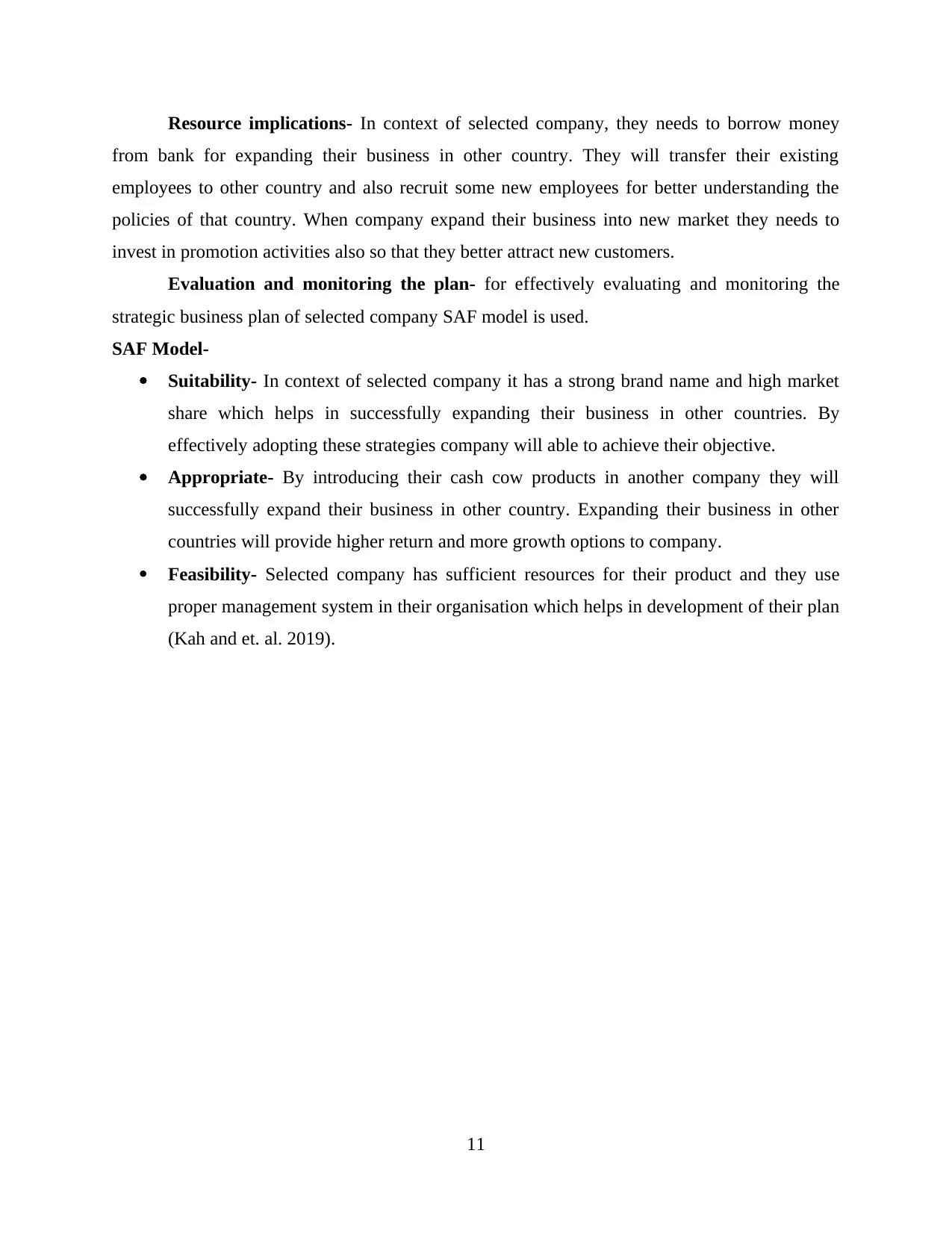
Resource implications- In context of selected company, they needs to borrow money
from bank for expanding their business in other country. They will transfer their existing
employees to other country and also recruit some new employees for better understanding the
policies of that country. When company expand their business into new market they needs to
invest in promotion activities also so that they better attract new customers.
Evaluation and monitoring the plan- for effectively evaluating and monitoring the
strategic business plan of selected company SAF model is used.
SAF Model-
Suitability- In context of selected company it has a strong brand name and high market
share which helps in successfully expanding their business in other countries. By
effectively adopting these strategies company will able to achieve their objective.
Appropriate- By introducing their cash cow products in another company they will
successfully expand their business in other country. Expanding their business in other
countries will provide higher return and more growth options to company.
Feasibility- Selected company has sufficient resources for their product and they use
proper management system in their organisation which helps in development of their plan
(Kah and et. al. 2019).
11
from bank for expanding their business in other country. They will transfer their existing
employees to other country and also recruit some new employees for better understanding the
policies of that country. When company expand their business into new market they needs to
invest in promotion activities also so that they better attract new customers.
Evaluation and monitoring the plan- for effectively evaluating and monitoring the
strategic business plan of selected company SAF model is used.
SAF Model-
Suitability- In context of selected company it has a strong brand name and high market
share which helps in successfully expanding their business in other countries. By
effectively adopting these strategies company will able to achieve their objective.
Appropriate- By introducing their cash cow products in another company they will
successfully expand their business in other country. Expanding their business in other
countries will provide higher return and more growth options to company.
Feasibility- Selected company has sufficient resources for their product and they use
proper management system in their organisation which helps in development of their plan
(Kah and et. al. 2019).
11
Paraphrase This Document
Need a fresh take? Get an instant paraphrase of this document with our AI Paraphraser
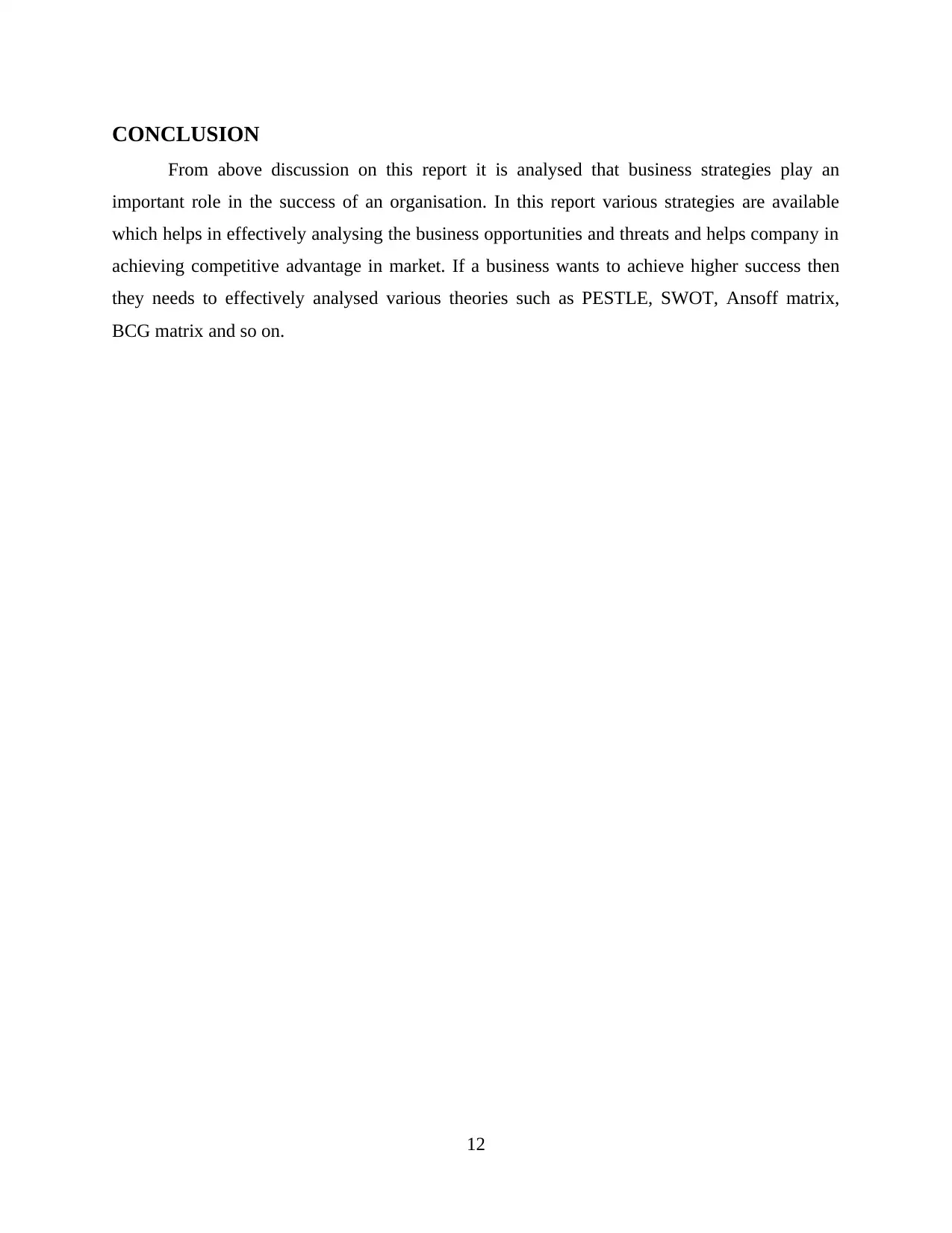
CONCLUSION
From above discussion on this report it is analysed that business strategies play an
important role in the success of an organisation. In this report various strategies are available
which helps in effectively analysing the business opportunities and threats and helps company in
achieving competitive advantage in market. If a business wants to achieve higher success then
they needs to effectively analysed various theories such as PESTLE, SWOT, Ansoff matrix,
BCG matrix and so on.
12
From above discussion on this report it is analysed that business strategies play an
important role in the success of an organisation. In this report various strategies are available
which helps in effectively analysing the business opportunities and threats and helps company in
achieving competitive advantage in market. If a business wants to achieve higher success then
they needs to effectively analysed various theories such as PESTLE, SWOT, Ansoff matrix,
BCG matrix and so on.
12
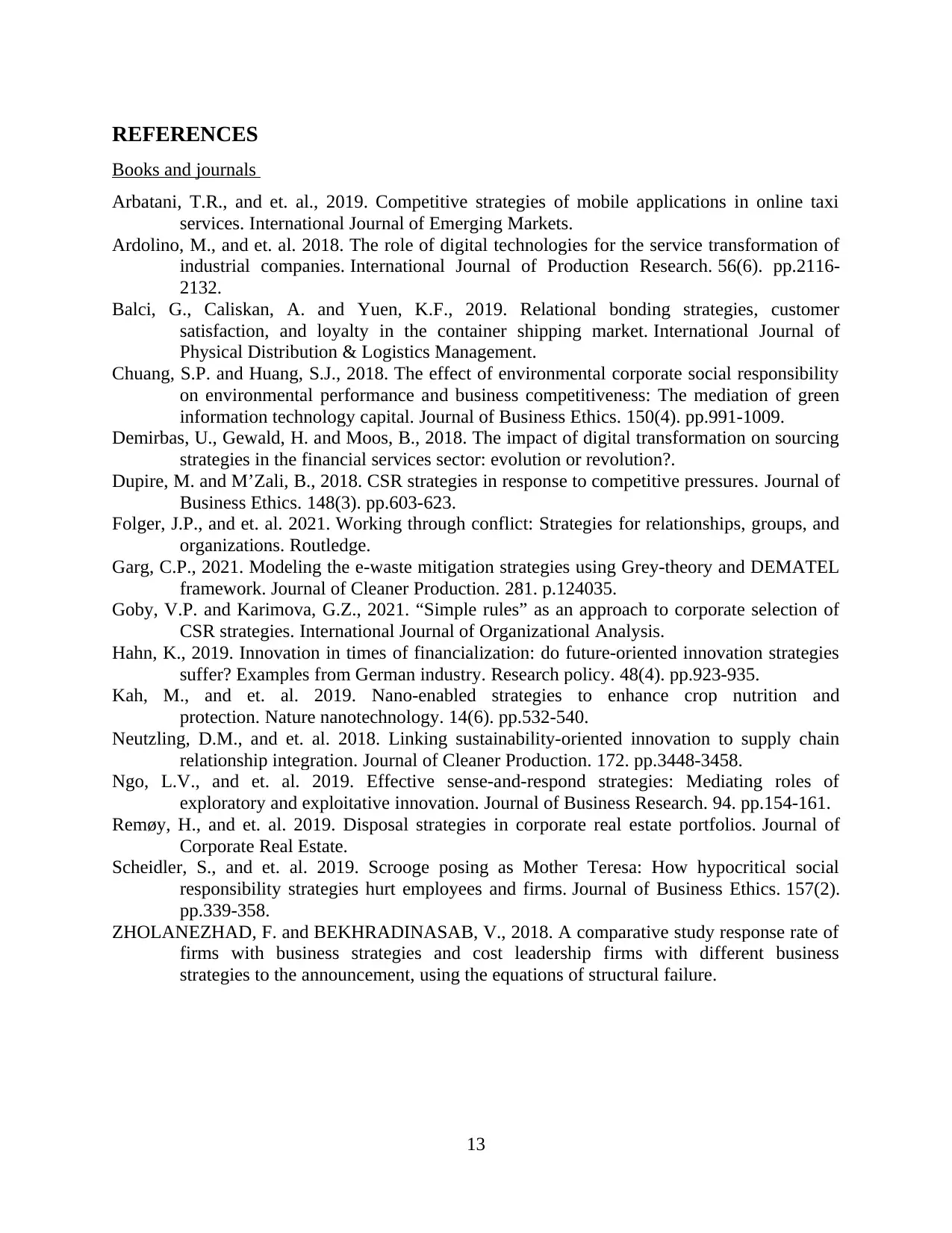
REFERENCES
Books and journals
Arbatani, T.R., and et. al., 2019. Competitive strategies of mobile applications in online taxi
services. International Journal of Emerging Markets.
Ardolino, M., and et. al. 2018. The role of digital technologies for the service transformation of
industrial companies. International Journal of Production Research. 56(6). pp.2116-
2132.
Balci, G., Caliskan, A. and Yuen, K.F., 2019. Relational bonding strategies, customer
satisfaction, and loyalty in the container shipping market. International Journal of
Physical Distribution & Logistics Management.
Chuang, S.P. and Huang, S.J., 2018. The effect of environmental corporate social responsibility
on environmental performance and business competitiveness: The mediation of green
information technology capital. Journal of Business Ethics. 150(4). pp.991-1009.
Demirbas, U., Gewald, H. and Moos, B., 2018. The impact of digital transformation on sourcing
strategies in the financial services sector: evolution or revolution?.
Dupire, M. and M’Zali, B., 2018. CSR strategies in response to competitive pressures. Journal of
Business Ethics. 148(3). pp.603-623.
Folger, J.P., and et. al. 2021. Working through conflict: Strategies for relationships, groups, and
organizations. Routledge.
Garg, C.P., 2021. Modeling the e-waste mitigation strategies using Grey-theory and DEMATEL
framework. Journal of Cleaner Production. 281. p.124035.
Goby, V.P. and Karimova, G.Z., 2021. “Simple rules” as an approach to corporate selection of
CSR strategies. International Journal of Organizational Analysis.
Hahn, K., 2019. Innovation in times of financialization: do future-oriented innovation strategies
suffer? Examples from German industry. Research policy. 48(4). pp.923-935.
Kah, M., and et. al. 2019. Nano-enabled strategies to enhance crop nutrition and
protection. Nature nanotechnology. 14(6). pp.532-540.
Neutzling, D.M., and et. al. 2018. Linking sustainability-oriented innovation to supply chain
relationship integration. Journal of Cleaner Production. 172. pp.3448-3458.
Ngo, L.V., and et. al. 2019. Effective sense-and-respond strategies: Mediating roles of
exploratory and exploitative innovation. Journal of Business Research. 94. pp.154-161.
Remøy, H., and et. al. 2019. Disposal strategies in corporate real estate portfolios. Journal of
Corporate Real Estate.
Scheidler, S., and et. al. 2019. Scrooge posing as Mother Teresa: How hypocritical social
responsibility strategies hurt employees and firms. Journal of Business Ethics. 157(2).
pp.339-358.
ZHOLANEZHAD, F. and BEKHRADINASAB, V., 2018. A comparative study response rate of
firms with business strategies and cost leadership firms with different business
strategies to the announcement, using the equations of structural failure.
13
Books and journals
Arbatani, T.R., and et. al., 2019. Competitive strategies of mobile applications in online taxi
services. International Journal of Emerging Markets.
Ardolino, M., and et. al. 2018. The role of digital technologies for the service transformation of
industrial companies. International Journal of Production Research. 56(6). pp.2116-
2132.
Balci, G., Caliskan, A. and Yuen, K.F., 2019. Relational bonding strategies, customer
satisfaction, and loyalty in the container shipping market. International Journal of
Physical Distribution & Logistics Management.
Chuang, S.P. and Huang, S.J., 2018. The effect of environmental corporate social responsibility
on environmental performance and business competitiveness: The mediation of green
information technology capital. Journal of Business Ethics. 150(4). pp.991-1009.
Demirbas, U., Gewald, H. and Moos, B., 2018. The impact of digital transformation on sourcing
strategies in the financial services sector: evolution or revolution?.
Dupire, M. and M’Zali, B., 2018. CSR strategies in response to competitive pressures. Journal of
Business Ethics. 148(3). pp.603-623.
Folger, J.P., and et. al. 2021. Working through conflict: Strategies for relationships, groups, and
organizations. Routledge.
Garg, C.P., 2021. Modeling the e-waste mitigation strategies using Grey-theory and DEMATEL
framework. Journal of Cleaner Production. 281. p.124035.
Goby, V.P. and Karimova, G.Z., 2021. “Simple rules” as an approach to corporate selection of
CSR strategies. International Journal of Organizational Analysis.
Hahn, K., 2019. Innovation in times of financialization: do future-oriented innovation strategies
suffer? Examples from German industry. Research policy. 48(4). pp.923-935.
Kah, M., and et. al. 2019. Nano-enabled strategies to enhance crop nutrition and
protection. Nature nanotechnology. 14(6). pp.532-540.
Neutzling, D.M., and et. al. 2018. Linking sustainability-oriented innovation to supply chain
relationship integration. Journal of Cleaner Production. 172. pp.3448-3458.
Ngo, L.V., and et. al. 2019. Effective sense-and-respond strategies: Mediating roles of
exploratory and exploitative innovation. Journal of Business Research. 94. pp.154-161.
Remøy, H., and et. al. 2019. Disposal strategies in corporate real estate portfolios. Journal of
Corporate Real Estate.
Scheidler, S., and et. al. 2019. Scrooge posing as Mother Teresa: How hypocritical social
responsibility strategies hurt employees and firms. Journal of Business Ethics. 157(2).
pp.339-358.
ZHOLANEZHAD, F. and BEKHRADINASAB, V., 2018. A comparative study response rate of
firms with business strategies and cost leadership firms with different business
strategies to the announcement, using the equations of structural failure.
13
1 out of 15
Related Documents
Your All-in-One AI-Powered Toolkit for Academic Success.
+13062052269
info@desklib.com
Available 24*7 on WhatsApp / Email
![[object Object]](/_next/static/media/star-bottom.7253800d.svg)
Unlock your academic potential
© 2024 | Zucol Services PVT LTD | All rights reserved.




